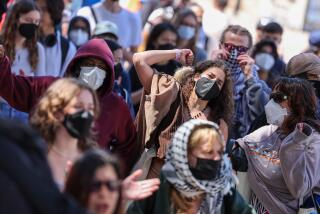Epitaph for a Democratic Experiment
- Share via
Robert Maynard Hutchins had been dean of the Yale Law School and president of the University of Chicago when, in the 1950s, he concluded that American universities were structurally incapable of pursuing certain important intellectual tasks. They were organized to expand knowledge by pursuing research along evermore specialized disciplinary paths. But America lacked institutions where knowledge was integrated across disciplinary boundaries and then applied to democracy’s condition through that universal public discourse that the Founders had thought the lifeblood of republics.
Society needed what universities produced, a body of increasingly esoteric research. But this was the ‘50s, when liberties were being sacrificed on the altar of the Cold War. For Hutchins, intellect was urgently challenged but he found the academy a cramped place for bold minds. It directed inquiries into research minutiae rather than toward the clarification of society’s fundamental direction; it would not seriously scan the future, and in any event could not communicate to laymen what it had discovered.
So Hutchins left the academy, and established that place with the awkward name, the Center for the Study of Democratic Institutions, on a hilltop in Montecito, Calif., just down the road from Santa Barbara. There, each morning at 11 Fellows would leave their cubicles and participate in “the Dialogue,” where they were enjoined to think on democracy’s foundations. They spoke the English language without disciplinary jargon, so that the public might find clarification in their work. The center magazine conveyed the product of the Dialogue to a membership that exceeded 100,000 as the 1970s arrived.
The center had its critics (some on the inside), but it had a remarkable run. Center members and others will remember the pioneering explorations of a legal regime for the oceans, the early exposure of the blunder into Vietnam, continuing illumination of civil rights and liberties, of global environmental deterioration. The white building on the hill attracted Niebuhr and Toynbee, Adler and Huxley, Tugwell and Myrdal. The brightest graduates of our universities were drawn there as interns; angry right-wingers stuffed canine excrement into the center mailbox and phoned in their threats. The center was making a difference.
But as Hutchins approached retirement, internal difficulties mounted. The large cadre of tenured Fellows had become expensive, and restricted resources prompted internal divisions. Hutchins completed a drastic reorganization in 1975, leaving the basic center idea intact but with inadequate funds to fill the chairs around the table.
Perhaps the universities could become a part of the solution. Hutchins asked me to take leave from the UC Santa Barbara campus and assist him in locating scholarly talent to augment the continuing Dialogue. We began to forge the links back to the academy he had left in the 1950s, and Hutchins thought the new arrangement promising. A small core of Fellows was reinforced by those professors who shared the center’s interests and could contribute to its explorations. There were more of them than Hutchins remembered from the 1950s. Perhaps the center had found the means to its ends.
But Hutchins was mortal. When he died in 1977, his successor could not sustain the operation. The nearby University of California took over the institution in 1979. Hutchins’ center, with its expansive and inherently controversial mission, in harness with academic administrators? In 1979 I joined others in thinking it not impossible.
The center had a turbulent life on the UCSB campus from 1979 to 1987 under the guidance of seven different heads. Now we hear that the experiment has failed. What is left of the center--a magazine without the old vitality, a name that evokes departed people and hopes, perhaps a concept for organizing society’s intellect--has been carried away to a think tank founded by former California Gov. Edmund G. Brown Jr. And St. John’s College hopes to revive the Dialogue. May they prosper. But, so dispersed, they are not “the Center,” which is no more.
And what are we to make of Hutchins’ California-based adventure? He was right about the universities’ shortcomings, and his effort to build a supplementary institution was brilliantly innovative, and, as he always conceded, flawed. At the end, some of us hoped that the intellectual and educational function he envisaged could be accomplished in collaboration with universities. He explored one form of such collaboration at the end. Another version, on the UCSB campus, has just failed. But the experience of the center’s last decade should not obscure the promise stirring there. A leadership of vision could not be found or sustained in those years at that site. But Hutchins never believed that only he could lead such an enterprise. If his legacy is a confidence in democracy, we must agree.
Those of us who revere America’s universities, and know their necessary limitations, will not find in the full story of Hutchins’ center a discouraging tale, but instead one of institutional innovations yet unfinished and never more urgently needed. The center is dead; long live the center.


